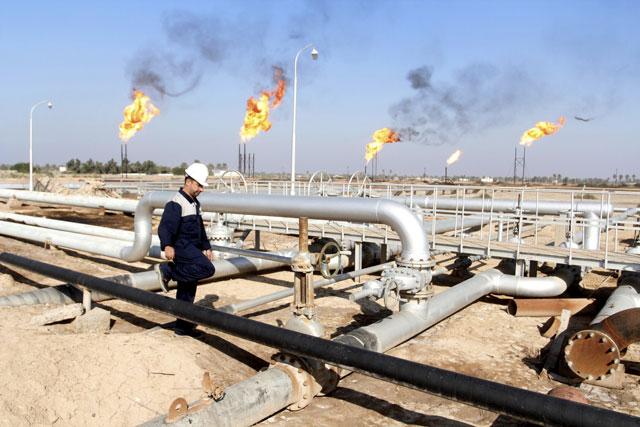You are here
Oil slide weighs heavily on MENA growth forecast — IMF
By AFP - Oct 10,2017 - Last updated at Oct 10,2017

A worker walks at Nahr Bin Umar Oil Field, north of Basra, Iraq, on December 21, 2015 (Reuters file photo)
DUBAI — A massive slide in the economic growth of Middle East top oil exporters is weighing heavily on the outlook for the entire region, the International Monetary Fund (IMF) said on Tuesday.
“Fuel exporters are particularly hard hit by the protracted adjustment to lower commodity revenues,” the IMF said in its World Economic Outlook for October.
Iran’s growth is forecast to slide to 3.5 per cent this year down from a strong 12.5 per cent in 2016.
Iraq’s economy, which experienced healthy 11 per cent growth in 2016, is expected to fall into negative territory and shrink by 0.4 per cent this year.
The Saudi economy, the largest in the region, is forecast to end 2017 flat — down from 1.7 per cent growth last year.
Saudi Arabia, Iraq and Iran are the top oil producers and exporters in the Middle East. Riyadh is the world’s top oil exporter.
Kuwait’s economy is projected to shrink the most among oil exporters, by 2.1 per cent, while the economies of the United Arab Emirates and Algeria will grow at a modest rate, the IMF said.
In all, the growth of MENA oil exporters Iran, Iraq, Algeria and the six Gulf Cooperation Council states is forecast to end this year at 1.7 per cent from 5.6 per cent in 2016.
MENA growth as a whole is projected to more than halve in 2017, from 5.1 per cent to 2.2 per cent, “on the back of a slowdown in the Islamic Republic of Iran’s economy after very fast growth in 2016 and cuts in oil production in oil exporters”, the IMF said.
It projected the price of oil to average $50.3 a barrel in 2017, higher than the previous year, but will remain in the 50s until 2022.
Regional oil exporters have lost hundreds of billions of dollars in revenue since crude prices began to slump in mid-2014.
As a result, they have posted budget shortfalls and some have resorted to painful reforms.
The IMF welcomed Saudi Arabia’s reform package, although it has already sent the kingdom’s economy into the red in the first two quarters of the year.
In contrast to these exporters, economic growth in oil-importing nations — which include Egypt, Morocco, Sudan and others — is forecast to improve to 4.3 per cent this year from 3.6 per cent in 2016, the IMF said.
The IMF had a better outlook for 2018, forecasting a rebound in growth to 3.2 percent compared with just 3 per cent in its July outlook.
The adjustment is due to stronger domestic demand in oil-importing countries and an expected rise in oil output.
The diplomatic rift between Organisation of Petroleum Exporting Countries member Qatar — also the world’s top exporter of liquefied natural gas — and a Saudi-led Arab bloc has not affected oil and gas markets, as Qatar’s exports have continued, the IMF said.
However, the report warned of the impact of ongoing conflicts, both domestic and regional.
“Internal and cross-border conflict in parts of the Middle East still weighed on economic activity,” it said.
Related Articles
The International Monetary Fund (IMF) has lowered its economic growth forecasts for most Arab countries over unrest in the region but said growth would remain generally strong in the oil-rich Gulf states.
AMMAN — The World Bank (WB) on Tuesday said growth in the Middle East and North Africa (MENA) region is estimated to have slowed to 2.
DUBAI — Economic growth in Saudi Arabia and most other Arab oil exporters will slow this year following production cuts aimed at propping up

















